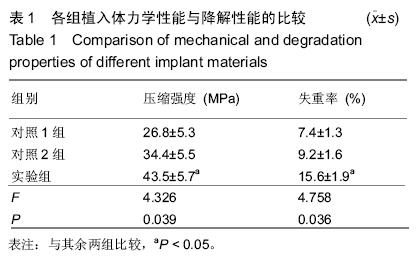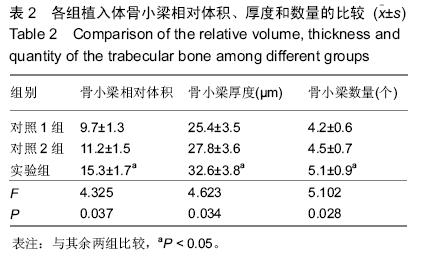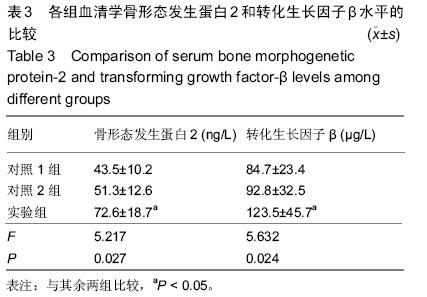| [1] Mithal A,Dhingra V,Lau E.The Asian audit: Epidemiology, costs and burden of osteoporosis in Asia. Beizing, China: An International Osteoporosis Foundation (IOF) publication,2009.[2] Ward E,Munk PL,Rashid F,et al.Musculoskeletal interventional radiology: radiofrequency ablation. Radiol Clin North Am.2008;46:599-610.[3] Cummings SR,San Martin J,Mc Clung MR,et al.FREEDOM Trial. Denosumab for prevention of fractures in postmenopausal women with osteoporosis. N Engl J Med.2009;361(8):756-765. [4] Aghaloo T,Felsenfeld A,Tetradis S.Osteonecrosis of the jaw in a patient on denosumab. J Oral Maxillofac Surg.2010;68(5):959-963. [5] Taylor KH,Middlefell LS,Mizen KD.Osteonecrosis of the jaws induced by anti-RANK ligand therapy.Br J Oral Maxillofac Surg.2010;48(3):221-223.[6] Xu HHK,Zhao L,Detamore MS,et al.Umbilical cord stem cell seeding on fast-resorbable calcium phosphate bone cement.Tissue Eng A.2010;16: 2743-2753. [7] 叶冬平,周子强,梁伟国.一种可注射自固化含锶复合胶原磷酸钙骨水泥的结构和性能[J].中国组织工程研究与临床康复,2009,13(38):7411.[8] Bone HG,McClung MR,Roux C.Odanacatib, a cathepsin-K inhibitor for osteoporosis: a two-year study in postmenopausal women with low bone density.J Bone Miner Res.2010;25(5):937-947.[9] Ginebra MP,Canal C,Espanol M,et al.Calcium phosphate cements as drug delivery materials. Adv Drug Del Rev.2012;64:1090-1110. [10] Lanao RP,Leeuwenburgh SC,Wolke JG,et al. In vitro degradation rate of apatite calcium phosphate cement with incorporated PLGA microspheres. Acta Biomater. 2011;7:3459-3468.[11] Yuan H,Bruijn JD,Zhang X,et al.Bone induction by porous glass ceramic made from Bioglass(45S5).J Biomed Mater Res.2001;58(3):270-276. [12] Kirk JF,Ritter G,Waters C,et al.Osteoconductivity and osteoinductivity of NanoFUSE® DBM.Cell Tissue Bank. 2013;14(1):33-44. [13] Rojbani H,Nyan M,Ohka K,et al.Evaluation of the osteoconductivity of α-tricalcium phosphate, β-tricalcium phosphate, and hydroxyapatite combined with or without simvastatin in rat calvarial defect.J Biomed Mater Res Part A.2011;98:488-498.[14] Hoppe A,Guldal NS,Boccaccini AR. A review of the biological response to ionic dissolution products from bioactive glasses and glass-ceramics. Biomaterials. 2011; 32(11):2757-2774.[15] Gerhardt LC,Widdows KL,Erol MM,et al.The pro-angiogenic properties of multi-functional bioactive glass composite scaffolds.Biomaterials.2011; 32(17): 4096-4108.[16] Hautamaki M,Meretoja VV,Mattila RH,et al.Osteoblast response to polymethyl methacrylate bioactive glass composite.J Mater Sci Mater Med.2010;21:1685-1692.[17] Nogueira ML,Lucas R,Ramos I,et al.Osteodensimetric curves in a female population.Acta Reumatol Port. 2011; 36(2):126-136.[18] Sendtner E,Renkawitz T,Kramny P,et a.l Fractured neck of femur--internal fixation versus arthroplasty. Dtsch Arztebl Int.2010;107(23):401-407.[19] Katsumura S,Ezura Y,Izu Y,et al.Beta Adrenergic Receptor Stimulation Suppresses Cell Migration in Association with Cell Cycle Transition in Osteoblasts-Live Imaging Analyses Based on FUCCI System.J Cell Physiol. 2016;231(2):496-504.[20] Buckens CF,van der Graaf Y,Verkooijen HM,et al. Osteoporosis markers on low-dose lung cancer screening chest computed tomography scans predict all-cause mortality. Eur Radiol.2015;25(1):132-139. [21] Leite AF,Souza Figueiredo PT,Caracas H,et al. Systematic review with hierarchical clustering analysis for the fractal dimension in assessment of skeletal bone mineral density using dental radiographs.Oral Radiol.2015;31(1):1-13.[22] Liu YQ,Han XF,Liu T,et al. A cell-based model of bone remodeling for identifying activity of icarrin in the treatment of osteoporosis.Biotechnol Lett.2015; 37(1): 219-226.[23] Gosch M,Druml T,Nicholas JA,et al.Fragility non-hip fracture patients are at risk.Arch Orthop Trauma Surg. 2015;135(1):69-77.[24] Kim HJ,Park TJ,Ahn KM.Bisphosphonate-related osteonecrosis of the jaw in metastatic breast cancer patients: a review of 25 cases.Maxillofac Plast Reconstr Surg.2016;38(1):6.[25] Ballas EG,Mavrogenis AF,Karamanis E,et al.Low-energy femoral shaft fractures after long-term alendronate therapy: report of seven cases.Eur J Orthop Surg Traumatol.2015;25(1):181-187.[26] Schröder K.NADPH oxidases in bone homeostasis and osteoporosis.Cell Mol Life Sci.2015;72(1):25-38.[27] Sale JE,Hawker G,Cameron C,et al.Perceived messages about bone health after a fracture are not consistent across healthcare providers.Rheumatol Int. 2015;35(1):97-103.[28] Zhang H,Tao X,Wu J.Association of calcitonin receptor gene polymorphism with bone mineral density in postmenopausal Chinese women: a meta-analysis. Arch Gynecol Obstet.2015;291(1):165-172.[29] Reid IR.Effects of vitamin D supplements on bone density.J Endocrinol Invest. 2015;38(1):91-94.[30] Ishtiaq S,Fogelman I,Hampson G.Treatment of post-menopausal osteoporosis: beyond bisphosphonates.J Endocrinol Invest.2015;38(1): 13-29. [31] Isidori AM,Balercia G,Calogero AE,et al.Outcomes of androgen replacement therapy in adult male hypogonadism: recommendations from the Italian society of endocrinology.J Endocrinol Invest.2015; 38(1):103-112.[32] Makita K,Okano H,Furuya T,et al.Survey of the utility of once-monthly bisphosphonate treatment for improvement of medication adherence in osteoporosis patients in Japan.J Bone Miner Metab.2015;33(1): 55-60.[33] Horst-Sikorska W,Dytfeld J,Wawrzyniak A,et al.Vitamin D receptor gene polymorphisms, bone mineral density and fractures in postmenopausal women with osteoporosis.Mol Biol Rep.2013;40(1):383-390. [34] Peppone LJ,Mustian KM,Rosier RN,et al.Bone health issues in breast cancer survivors: a Medicare Current Beneficiary Survey (MCBS) study.Support Care Cancer. 2014;22(1):245-251.[35] Venmans A,Lohle PN,van Rooij WJ.Pain course in conservatively treated patients with back pain and a VCF on the spine radiograph (VERTOS III).Skeletal Radiol. 2014;43(1):13-18.[36] Mikami Y,Matsumoto T,Kano K,et al.Current status of drug therapies for osteoporosis and the search for stem cells adapted for bone regenerative medicine. Anat Sci Int.2014;89(1):1-10. [37] Iino M, Kozai Y,Kawamata R,et al. Effects of β-cryptoxanthin on bone-formation parameters in the distal femoral epiphysis of ovariectomized mice.Oral Radiol.2014;30(1):1-8.[38] Miura T,Kozai Y,Kawamata R,et al.Inhibitory effect of a fermented soy product from lactic acid bacteria (PS-B1) on deterioration of bone mass and quality in ovariectomized mice.Oral Radiol.2014;30(1):45-52.[39] Berendsen AD,Olsen BR.Osteoblast-adipocyte lineage plasticity in tissue development, maintenance and pathology.Cell Mol Life Sci.2014;71(3):493-497.[40] Roux C,Binkley N,Boonen S,et al.Vitamin D status and bone mineral density changes during alendronate treatment in postmenopausal osteoporosis.Calcif Tissue Int.2014;94(2):153-157.[41] Jeon YK,Kim KM,Kim KJ, et al.The anabolic effect of teriparatide is undermined by low levels of high-density lipoprotein cholesterol.Calcif Tissue Int. 2014;94(2): 159-168.[42] He Q,Chen H,Huang L,et al.Porous surface modified bioactive bone cement for enhanced bone bonding. PLoS One.2012;7:e42525. |





